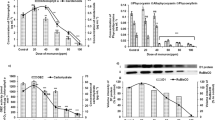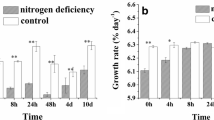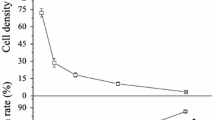Abstract
This study investigated the effects of glufosinate, a widely used herbicide, on the marine diatom Phaeodactylum tricornutum through short-term toxicity tests at the physiological and gene transcriptional levels. Glufosinate (4 mg L−1) decreased the amount of pigments but increased reactive oxygen species (ROS) and malondialdehyde levels. As a glutamine synthetase (GS) inhibitor, glufosinate affected the transcripts and activities of key enzymes related to nitrogen assimilation. Transcript levels of GS and nitrate reductase (NR) in P. tricornutum decreased to only 57 and 26 % of the control. However, transcript levels of nitrate transporter (NRT) and the small subunit of glutamate synthase (GltD) were 1.79 and 1.76 times higher than that of the control. The activities of NRT, GS and GOGAT were consistent with gene expression except for NR, which was regulated mainly by post-translational modification. Furthermore, the results of electron microscopy showed that chloroplast structure was disrupted in response to glufosinate exposure. These results demonstrated that glufosinate first disturbed nitrogen metabolism and caused a ROS burst, which disrupted chloroplast ultrastructure. Ultimately, the growth of P. tricornutum was greatly inhibited by glufosinate.







Similar content being viewed by others
References
Ahn IP (2008) Glufosinate ammonium-induced pathogen inhibition and defense responses culminate in disease protection in bar-transgenic rice. Plant Physiol 146:213–217
Allen AE, Vardi A, Bowler C (2006) An ecological and evolutionary context for integrated nitrogen metabolism and related signaling pathways in marine diatoms. Curr Opin Plant Biol 9:264–273
Archibald JM, Keeling PJ (2002) Recycled plastids: a ‘green movement’ in eukaryotic evolution. Trends Genet 18:577–584
Barhoumi Z, Djebali W, Chaïbi W, Abdelly C, Smaoui A (2007) Salt impact on photosynthesis and leaf ultrastructure of Aeluropus littoralis. J Plant Res 120:529–537
Barrios-Llerena ME, Pritchard JC, Kerr LE et al (2011) The use of a novel quantitation strategy based on Reductive Isotopic Di-Ethylation (RIDE) to evaluate the effect of glufosinate on the unicellular algae Ostreococcus tauri. J Proteomics 74:2798–2809
Blackwell R, Murray A, Lea P (1987) Inhibition of photosynthesis in barley with decreased levels of chloroplastic glutamine synthetase activity. J Exp Bot 38:1799–1809
Bübl W, Langelüddeke P (1984) Basta-ein modernes Herbizid für den Weinbau. Der Dt Weinbau 18:850–851
Coetzer E, Al-Khatib K (2001) Photosynthetic inhibition and ammonium accumulation in Palmer amaranth after glufosinate application. Weed Sci 49:454–459
Djebali W, Zarrouk M, Brouquisse R, El Kahoui S, Limam F, Ghorbel M, Chaïbi W (2005) Ultrastructure and lipid alterations induced by cadmium in tomato (Lycopersicon esculentum) chloroplast membranes. Plant Biol 7:358–368
Duan F, Zhang M, Fan S, Duan J, Li Y, Liang C (2003) Effects of glufosinate on GS activity and photosynthetic function of bar-transgenic rice. Mol Plant 29:530–534 (in Chinese)
Fernandez E, Galvan A (2008) Nitrate assimilation in Chlamydomonas. Eukaryot Cell 7:555–559
Fischer P, Klein U (1988) Localization of nitrogen-assimilating enzymes in the chloroplast of Chlamydomonas reinhardtii. Plant Physiol 88:947–952
Franco AR, Cárdenas J, Fernández E (1987) Involvement of reversible inactivation in the regulation of nitrate reductase enzyme levels in Chlamydomonas reinhardtii. Plant Physiol 84:665–669
Haimovich-Dayan M, Garfinkel N, Ewe D, Marcus Y, Gruber A, Wagner H, Kroth PG, Kaplan A (2013) The role of C4 metabolism in the marine diatom Phaeodactylum tricornutum. New Phytol 197:177–185
Lepetit B, Volke D, Szabo M et al (2007) Spectroscopic and molecular characterization of the oligomeric antenna of the diatom Phaeodactylum tricornutum. Biochemistry 46:9813–9822
Lesser MP (2006) Oxidative stress in marine environments: biochemistry and physiological ecology. Annu Rev Physiol 68:253–278
Livak KJ, Schmittgen TD (2001) Analysis of relative gene expression data using real-time quantitative PCR and the 2−ΔΔCT method. Methods 25:402–408
Logusch EW, Walker DM, McDonald JF, Franz JE (1991) Inhibition of plant glutamine synthetases by substituted phosphinothricins. Plant Physiol 95:1057–1062
Manderscheid R, Wild A (1986) Studies on the mechanism of inhibition by phosphinothricin of glutamine synthetase isolated from Triticum aestivum. J Plant Physiol 123:135–142
Miller AJ, Fan X, Shen Q, Smith SJ (2008) Amino acids and nitrate as signals for the regulation of nitrogen acquisition. J Exp Bot 59:111–119
Niu L, Gui W, Zhu G (2010) The degradation of glufosinate in water and toxicity to aquatic organism. Acta Agric Zhejiangensis 22:485–490 (in Chinese)
Owens TG (1986) Light-harvesting function in the diatom Phaeodactylum tricornutum II. Distribution of excitation energy between the photosystems. Plant Physiol 80:739–746
Pozuelo M, MacKintosh C, Galván A, Fernández E (2001) Cytosolic glutamine synthetase and not nitrate reductase from the green alga Chlamydomonas reinhardtii is phosphorylated and binds 14-3-3 proteins. Planta 212:264–269
Pyszniak AM, Gibbs SP (1992) Immunocytochemical localization of photosystem I and the fucoxanthin-chlorophylla/c light-harvesting complex in the diatom Phaeodactylum tricornutum. Protoplasma 166:208–217
Qian H, Chen W, Sheng GD, Xu X, Liu W, Fu Z (2008) Effects of glufosinate on antioxidant enzymes, subcellular structure, and gene expression in the unicellular green alga Chlorella vulgaris. Aquat Toxicol 88:301–307
Qian H, Yu S, Sun Z, Xie X, Liu W, Fu Z (2010) Effects of copper sulfate, hydrogen peroxide and N-phenyl-2-naphthylamine on oxidative stress and the expression of genes involved photosynthesis and microcystin disposition in Microcystis aeruginosa. Aquat Toxicol 99:405–412
Qian H, Peng X, Han X, Ren J, Sun L, Fu Z (2013a) Comparison of the toxicity of silver nanoparticles and silver ion on the growth of terrestrial plant model Arabidopsis thaliana. J Environ Sci-China. 25:1947–1955
Qian H, Sun Z, Sun L, Jiang Y, Wei Y, Xie J, Fu Z (2013b) Phosphorus availability changes chromium toxicity in the freshwater alga Chlorella vulgaris. Chemosphere 93:885–891
Reddy KN, Hoagland RE, Zablotowicz RM (2001) Effect of glyphosate on growth, chlorophyll, and nodulation in glyphosate-resistant and susceptible soybean (Glycine max) varieties. J New Seeds 2:37–52
Rojano-Delgado AM, Priego-Capote F, Barro F, Luque de Castro MD, De Prado R (2013) Liquid chromatography-diode array detection to study the metabolism of glufosinate in Triticum aestivum T-590 and influence of the genetic modification on its resistance. Phytochemistry 96:117–122
Royer A, Beguin S, Sochor H, Communal PY (2000) Determination of glufosinate ammonium and its metabolite (AE F064619 and AE F061517) residues in water by gas chromatography with tandem mass spectrometry after ion exchange cleanup and derivatization. J Agric Food Chem 48:5184–5189
Schwerdtle F, Bieringer H, Finke M (1981) HOE 39866-ein neues nicht selektives Blattherbizid. Z Pflanzenkrankheiten Pflanzenschutz 9:431–440
Shaner DL (2000) The impact of glyphosate-tolerant crops on the use of other herbicides and on resistance management. Pest Manag Sci 56:320–326
Solomonson LP, Barber MJ (1990) Assimilatory nitrate reductase: functional properties and regulation. Annu Rev Plant Biol 41:225–253
Wendler C, Barniske M, Wild A (1990) Effect of phosphinothricin (glufosinate) on photosynthesis and photorespiration of C3 and C4 plants. Photosynth Res 24:55–61
Whitton BA, Kelly MG (1995) Use of algae and other plants for monitoring rivers. Aust J Ecol 20:45–56
Yamauchi Y, Furutera A, Seki K, Toyoda Y, Tanaka K, Sugimoto Y (2008) Malondialdehyde generated from peroxidized linolenic acid causes protein modification in heat-stressed plants. Plant Physiol Biochem 46:786–793
Yang H, Duan S (2010) The ecological toxic effects of dibutyl phthalate on Phaeodactylum tricornutum. Ecol Environ Sci 19:2155–2159 (in Chinese)
Acknowledgments
This work was financially supported by the National Basic Research Program of China (No. 2010CB126100) and Supported by Program for Changjiang Scholars and Innovative Research Team in University (IRT13096).
Conflict of interest
The authors declare that they have no conflict of interest.
Author information
Authors and Affiliations
Corresponding author
Rights and permissions
About this article
Cite this article
Xie, J., Bai, X., Li, Y. et al. The effect of glufosinate on nitrogen assimilation at the physiological, biochemical and molecular levels in Phaeodactylum tricornutum . Ecotoxicology 23, 1430–1438 (2014). https://doi.org/10.1007/s10646-014-1285-8
Accepted:
Published:
Issue Date:
DOI: https://doi.org/10.1007/s10646-014-1285-8




